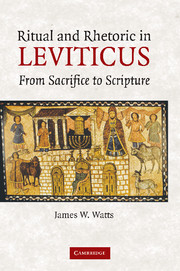Book contents
- Frontmatter
- Contents
- Abbreviations
- Preface
- Ritual and rhetoric in Leviticus
- 1 Introduction: Ritual Text and Ritual Interpretation
- 2 The Rhetoric of Ritual Instruction
- 3 The Rhetoric of Burnt Offerings
- 4 The Rhetoric of Sin, Guilt, and Ritual Offerings
- 5 The Rhetoric of Ritual Narrative
- 6 The Rhetoric of Atonement
- 7 The Rhetoric of Priesthood
- 8 The Rhetoric of Sacrifice
- 9 The Rhetoric of Scripture
- Bibliography
- Index of Biblical Citations
- Index of Other Ancient Literature
- Index of Authors
- Index of Subjects
1 - Introduction: Ritual Text and Ritual Interpretation
Published online by Cambridge University Press: 22 July 2009
- Frontmatter
- Contents
- Abbreviations
- Preface
- Ritual and rhetoric in Leviticus
- 1 Introduction: Ritual Text and Ritual Interpretation
- 2 The Rhetoric of Ritual Instruction
- 3 The Rhetoric of Burnt Offerings
- 4 The Rhetoric of Sin, Guilt, and Ritual Offerings
- 5 The Rhetoric of Ritual Narrative
- 6 The Rhetoric of Atonement
- 7 The Rhetoric of Priesthood
- 8 The Rhetoric of Sacrifice
- 9 The Rhetoric of Scripture
- Bibliography
- Index of Biblical Citations
- Index of Other Ancient Literature
- Index of Authors
- Index of Subjects
Summary
In a book about medieval rituals, Philippe Buc argued: “Texts were forces in the practice of power. They should not be decrypted for (elusive) facts about rituals and then set aside.” He arrived at this conclusion by observing that ritual meaning was a gamble and was always contested in medieval societies and in medieval texts. As a result, Buc reached a negative conclusion about how far medieval texts can be used in the study of ritual:
Ultimately there can be no anthropological readings of rituals depicted in medieval texts. There can only be anthropological readings of (1) medieval textual practices or perhaps (2) medieval practices that the historian has reconstructed using texts, with full and constant sensitivity to their status as texts. The latter is nonetheless much more difficult (especially for data-poor eras), less reliable, and allows only a circumscribed realm of appropriate questions and possible results.
What Buc calls “data-poor eras” must surely include the times in which the ritual texts of the Bible were written. We know so little about them that dates for the composition of the priestly strand (P) in the Torah/Pentateuch range over five centuries. Yet anthropological readings of ritual instructions and stories in the books of Leviticus and Numbers have multiplied in recent decades. They have been motivated by a wish to use twentieth-century parallels to understand Israel's ancient ritual practices, but they have also been used by interpreters to reconstruct the theological rationales behind the rituals.
- Type
- Chapter
- Information
- Ritual and Rhetoric in LeviticusFrom Sacrifice to Scripture, pp. 1 - 36Publisher: Cambridge University PressPrint publication year: 2007



